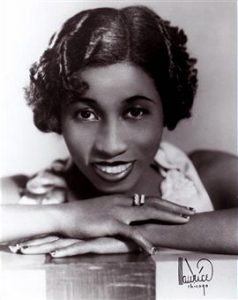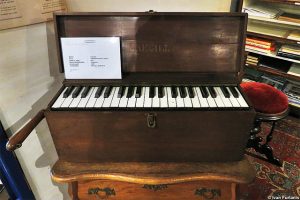
Photograph of Lil Hardin Armstrong who was a prominent jazz pianist, composer, arranger, singer, and bandleader during the jazz era. Lil Hardin-Armstrong is the second wife of Louis Armstrong. Photograph by Gilles Petard, circa 1940.
Music Period: 20th Century & beyond
Location: America
Claim to Fame: One of the most prominent jazz pianists of the time, later building a reputation as a jazz composer, arranger, and bandleader.
When one thinks of trumpeters and jazz, the name that instantly hits your lips is the great Louis Armstrong. Yet, many forget about his wife, Lil Hardin-Armstrong. She was a jazz pianist with an incredible reputation, arranged music for the hottest bands in the jazz business, and became a respected composer and bandleader in later years. Lil supported her husband during his early career, and encouraged him to establish himself as a solo artist. Without this encouragement, Louis Armstrong may never have gained the status he enjoyed. Lil Hardin-Armstrong helped to change the face of jazz forever through the promotion of her husband. She was without a doubt one of the most prominent women in early jazz.
Lil Hardin-Armstrong was born in Memphis on 2nd February 1898. As a young child, Lil started playing an old harmonium that she had found neglected in a small corner of the house where her family boarded. She spent many tireless hours spent trying to make the “thing moan and groan” as a result. Seeing this, her mother decided to arrange keyboard lessons for her daughter. It would be years later, whilst Lil was at university, before it transpired that the woman hired had a rather unusual approach to keyboard technique. The early mistakes in her training would forever contribute to the way Lil played the piano.
In 1918, Lil moved with her family to Chicago. It was a short while after moving when Lil would enter Jones Music Store and amaze the owner with her talent as a pianist. This led to a job offer at the store as a music demonstrator playing sheet music for customers who walked in. After learning all the sheet music available, Lil started to alter the songs she performed. She added embellishments, and incorporated aspects of the hard-driving jazz style perfected by her inspiration, Jelly Roll Morton, into the pieces. She soon built a reputation as a pianist, and became a local star attraction. Little did Lil know that this was the start of a long career as a jazz musician, composer, and arranger.
The key moment came in 1921 when Lil joined King Oliver’s Creole Jazz Band. Lil accompanied the band to San Francisco soon afterwards to play an extended six-month booking. It was whilst with the band that Lil would meet her second husband. The man was a young trumpeter from New Orleans called Louis Armstrong. After a slow start, the relationship soon blossomed, and the couple married on 5th February 1924. Lil believed that Louis was wasting his time playing second cornet in the band and convinced him to venture forth on his own. She gave him a new look and disregarded his “country” style that had come between them when they first met. The tact worked and Louis left to start playing another jazz band in New York. Lil returned to Chicago much sooner after struggling to find work in the male-dominated jazz scene in the big city. Thanks to Lil, and her promotional efforts, the New York experience made Louis a star. Okeh Records wanted to issue a series of sides under the Louis Armstrong name, and the celebrated “Hot Five” recordings came into being with Lil at the piano.

Image of a harmonium similar to the one Lil Hardin-Armstrong may have played when she was younger. Photograph by Ivan Furlanis.
The couple grew apart as Louis become more famous in the 1920s. They separated in 1931 and Lil continued performing as a bandleader and soloist. She went on to gain a music degree at the Chicago College of Music, and form two all-female bands in the early 1930s. Lil went on to lead an all-male band from 1933 – 1935 where the group struggled with their audience’s reception to a female bandleader.
This, however, did not stop her. She returned to Chicago and started recording with Decca Records as a swing vocalist. The following two decades saw Lil work as musical director for Decca Records, contributing to the Sepia Series and performing her own compositions internationally. It was by this time that music she had originally written for Louis had become jazz standards. When Ray Charles invited her to record Just For a Thrill in 1959, it stormed the charts, and became a major hit. The release led to Riverside Records approaching Lil in 1961 to do an album – an album that would end an incredible recording career spanning almost forty years.
Lil Hardin-Armstrong performing with Mae Barnes on the television special Chicago and All That Jazz in 1961.
This incredible female composer had a career that spanned more than forty years. She became one of the best jazz musicians of her time and was the driving force behind Louis Armstrong’s success for a time. Lil sought out opportunities for her husband to play whenever she could to promote his talents. Without this support, Louis Armstrong may never have come into being as a soloist. For Lil, her own career never seemed to settle with quite the same success. Despite her musical abilities, Lil faced more than one barrier to complete success and most, if not all, were because she was a women. It is sad to find that “the first lady of jazz” and her incredible achievements remain in the shadows out of sight.
This blog post used this Memphis Hall of Fame page as a research basis. If you would like to find out more about Lil Hardin-Armstrong, head over to http://www.theheroinecollective.com/lil-hardin/ and http://www.encyclopedia.com/people/history/historians-miscellaneous-biographies/lil-hardin-armstrong . For interview clips with Lil Hardin-Armstrong, check out http://rwj-a.stanford.edu/bonus-content/lil-hardin-interview-clips.
-Claire Amundson
Junior Girl
Girl Museum Inc.
